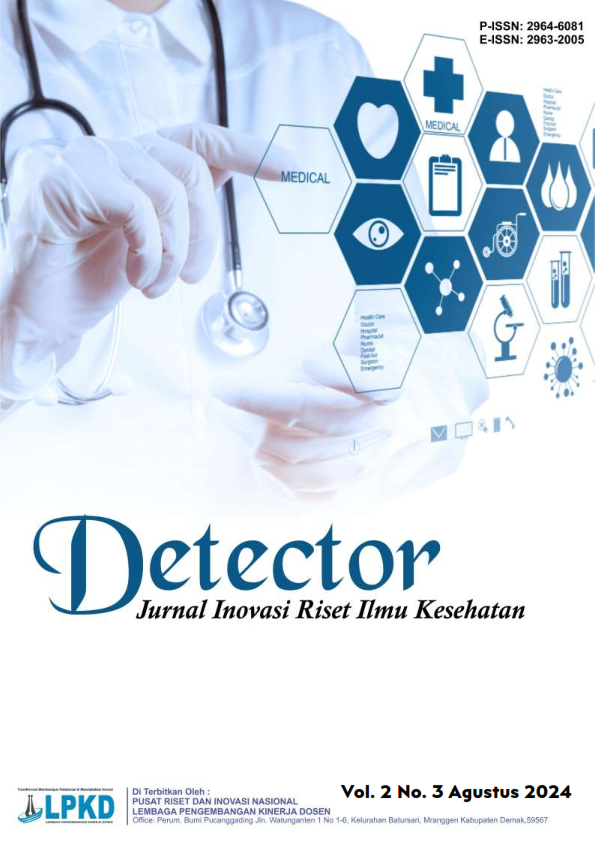Hubungan Konsumsi Kopi Dengan Kejadian Dismenore
Sebuah Tinjauan Literatur
DOI:
https://doi.org/10.55606/detector.v2i3.4009Keywords:
Coffee, Dysmenorrhea, Relationship, Literature ReviewAbstract
Coffee is a widely consumed beverage especially for Indonesian. Its consumption continues to increase. There is not much information and researches on the relationship between coffee consumption and dysmenorrhea. This literature study was conducted to find out more about the relationship between coffee consumption and the incidence of dysmenorrhea. This literature study is a narrative literature review, delves into the literature with an analytical observational design regarding the relationship between coffee consumption and the incidence of dysmenorrhea. The literature search was carried out through the PubMed, Proquest and ScienceDirect electronic databases based on predetermined inclusion and exclusion criteria. A total of 12 literatures were reviewed. From the results of the literature review, there are six literatures which state that coffee consumption is associated with dysmenorrhea and six other literatures state that coffee consumption is not associated with dysmenorrhea. The conclusion of this literature study is that the relationship between coffee consumption and the incidence of dysmenorrhea is still debatable .
Downloads
References
Hendarto H.Gangguan Haid/Perdarahan Uterus Abnormal. In: Anwar M, BaziadA, Prabowo R, editors. Ilmu Kandungan. 3rd ed. Jakarta: PT Bina Pustaka Sarwono Prawirohardjo; 2017.p.161-83.
Monday I, Anthony P, Olunu E, Otohinoyi D, Abiodun S, Owolabi A, et al. Prevalence and correlation between diet and dysmenorrhea among high school and college students in saint vincent and grenadines. Open Access Maced J MedSci. 2019;7(6):920–4.
Beddu S, Mukarramah S, Lestahulu V. Hubungan Status Gizi dan Usia Menarche Dengan Dismenore Primer pada Remaja Putri. SEAJOM SoutheastAsia J Midwifery. 2015;1(1):16–21.
Unsal A, Ayranci U, Tozun M, Arslan G, Calik E. Prevalence of dysmenorrhea and its effect on quality of life among a group of female university students. Ups J Med Sci. 2010;115(2):138–45.
Falabiba N. Faktor-Faktor Yang Berhubungan Dengan Dismenorea Pada Siswi SMP Negeri 3 Karawang Barat Kabupaten Karawang Tahun 2018.Jurnal Kebidanan Indonesia. 2019;10(1):39–48.
Kurniati B, Amelia R, Oktora MZ. Hubungan Indeks Massa Tubuh dengan Kejadian Dismenore pada Mahasiswi Angkatan 2015 Fakultas Kedokteran Universitas Baiturrahmah Padang. Heal Med J. 2019;1(2):07–11.
Wulanda C, Luthfi A, Hidayat R. Efektifitas Senam Disminore Pada Pagi Dan Sore Hari Terhadap Penanganan Nyeri Haid Pada Remaja Putri Saat Haid Di SMPN 2 Bangkinang Kota Thun 2019. J Kesehat Tambusai. 2020;1(1):1–11.
Hermawati, N. Ayu Gustia YD. Pengaruh Pemberian Air Rebusan Kunyit (Curcumin) Asam (Tamarindus Indica) Terhadap Intesitas Nyeri Haid (Disminore) Pada Siswi Kelas X Man 2 Padang Tahun 2020. J Kesehatan Saintika Meditory J Kesehat Saintika Meditory . 2018:79–88.
Joshi T, Kural M, Agrawal D, Noor N, Patil A. Primary dysmenorrhea and its effect on quality of life in young girls. Int J Med Sci Public Heal. 2015;4(3):381.
Larasati, T. A. A, Alatas F. Dismenore Primer dan Faktor Risiko Dismenore Primer pada Remaja. Majority. 2016;5(3):79–84.
Abduh Y. Biorefinery Kopi. 4th ed. Pusat Penelitian Biosains Dan Bioteknologi ITB. 2018;1–51.
Xanthine derivatives. J Chromatogr Libr. 1983;23:435–60.
Monteiro JP, Alves MG, Oliveira PF, Silva BM. Structure-bioactivity relationships of methylxanthines: Trying to make sense of all the promises and the drawbacks. Molecules. 2016;21(8).
Sanchez JM. Methylxanthine content in commonly consumed foods in Spain and determination of its intake during consumption. Foods. 2017;6(12).
Marchianti A, Nurus Sakinah E, Diniyah N et al. Efektifitas Penyuluhan Gizi pada Kelompok 1000 HPK dalam Meningkatkan Pengetahuan dan Sikap Kesadaran Gizi.Universitas Jember. 2017;3: 69–70 .
Wikoff D, Welsh BT, Henderson R, Brorby GP, Britt J, Myers E, et al. Systematic review of the potential adverse effects of caffeine consumption in healthy adults, pregnant women, adolescents, and children. Food Chem Toxicol. 2017;109:585–648.
Alrahal FA, Al-Matouq S, Al-Taiar A, Al-Basri D, Al-Mutairi H, Al-Enzi M, et al. Dysmenorrhea among high-school students and its associated factors in Kuwait. Arab Gulf J Sci Res. 2020;38:26.
Zhang X, Zhang R, Chen D, Huang R, Tian Y, Zhang P, et al. Association of tea drinking and dysmenorrhoea among reproductive-Age women in Shanghai, China (2013-2015): A cross-sectional study. BMJ Open. 2019;9(4):1–9.
Yusni Y, Rahman S. Kebiasaan konsumsi kopi teratur dan pengaruhnya terhadap resorpsi tulang: C-telopeptida dan kalsium serum pada olahragawan. J Gizi Indones (The Indones J Nutr). 2019;7(2):92–8.
Chandrasekaran K, Karunasagar D. Determination of trace elements in the Pb Bi-eutectic system by inductively coupled plasma-quadrupole mass spectrometry after sequential removal of the matrix by precipitation. J Anal At Spectrom. 2014;29(9):1720–5.
Bistara DN, Kartini Y. Hubungan Kebiasaan Mengkonsumsi Kopi dengan Tekanan Darah Pada Dewasa Muda. J Kesehatan Vokasional. 2018;3(1):23.
Bajalan Z, Alimoradi Z, Moafi F. Nutrition as a potential factor of primary dysmenorrhea: A systematic review of observational studies. Gynecol Obstet Invest. 2019;84(3):209–24.
Purdue-Smithe AC, Manson JE, Hankinson SE, Bertone-Johnson ER. A prospective study of caffeine and coffee intake and premenstrual syndrome. Am J Clin Nutr. 2016;104(2):499–507.
Zeru AB, Muluneh MA. Thyme Tea and Primary Dysmenorrhea Among Young Female Students. Adolesc Health Med Ther. 2020;11:147–55.
Ali Z, Burnett I, Eccles R, North M, Jawad M, Jawad S, et al. Efficacy of a paracetamol and caffeine combination in the treatment of the key symptoms of primary dysmenorrhoea. Curr Med Res Opin. 2007;23(4):841–51.
Reed BG, Carr BR. The Normal Menstrual Cycle and the Control of Ovulation. Endotext. 2000.
Hu Z, Tang L, Chen L, Kaminga AC, Xu H. Prevalence and Risk Factors Associated with Primary Dysmenorrhea among Chinese Female University Students: A Cross-sectional Study. J Pediatr Adolesc Gynecol. 2020;33(1):15–22.
Muluneh A, Nigussie T, Gebreslasie K, Anteneh K, Kassa Z.Prevalence And Associated Factors Of Dysmenorrhea Among Secondary And Preparatory School Students In Debremarkos Town,North-West Ethiopia.BMC Women's Health. 2018;1–8.
Pejcic A, Jankovic S. Risk factors for dysmenorrhea among young adult female university students.Ann 1st Super Sanita. 2016;52:98–103.
Fernandez-Martinez E, Onieva-Zafra MD, Parra-Fernandez ML. Lifestyle and prevalence of dysmenorrhea among Spanish female university students. 2018;1– 11
Kabuk u C, Kabuk u Başay B, Başay . Primary dysmenorrhea in adolescents: Association with attention deficit hyperactivity disorder and psychological symptoms. Taiwan J Obstet Gynecol. 2021;60(2):311–7.
Nakame RM, Kiwanuka F, Robert A. Dysmenorrhoea among students aged 18– 45 years attending University in Uganda: A cross‐sectional multicenter study of three Universities in Uganda. Nurs Open. 2019;6(2):268–75.
Abu Helwa H, Mitaeb A, Al-Hamshri S, Sweileh W. Prevalence of dysmenorrhea and predictors of its pain intensity among Palestinian female university students. BMC Womens Health. 2018;18(1):1–11.
Downloads
Published
How to Cite
Issue
Section
License
Copyright (c) 2024 Detector: Jurnal Inovasi Riset Ilmu Kesehatan

This work is licensed under a Creative Commons Attribution-ShareAlike 4.0 International License.








